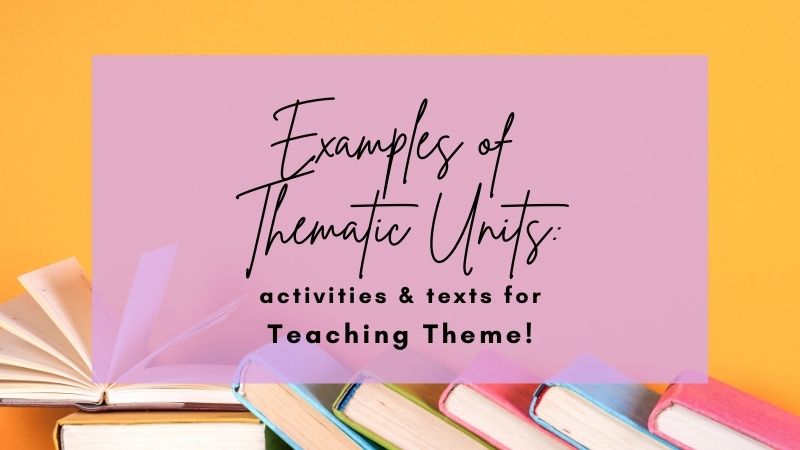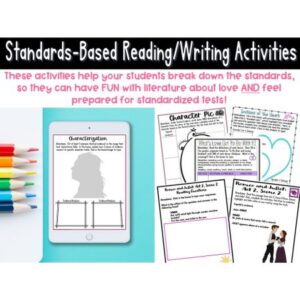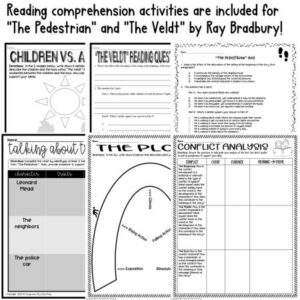In my years of teaching, I have found that the best way to get students learning AND retaining concepts and skills is by using thematic units. By integrating reading and writing together by focusing on a major topic and/or using a specific theme, you can incorporate texts in different genres and forms as well as different writing tasks. Teaching through thematic units in high school English means the potential for targeted skills practice, exposure to a variety of texts, and an increase in engagement (with the right choice of theme)! Keep reading for Examples of Thematic Unit Ideas!
Need help with Test Prep? Check out this FREE Pack of 3 Test Prep Activities to help students achieve success on standardized tests!
What is theme?
Theme, in general, is the deeper meaning of a story. It is often a recurring central idea that leads to a take-away message for the reader. Different parts of a story including characterization, plot, conflict, setting, and more, can each contribute to that message. These elements are important when using Examples of Thematic Unit!
What is notable about theme is that different texts may share a theme, but the way in which it is communicated to the reader is very different.
Take for example a theme like the following: “True love can endure even the greatest of hardships.” This theme would apply to William Shakespeare’s Romeo and Juliet as well as to O. Henry’s short story “The Gift of the Magi” though the two stories are quite different.
Check out this thematic unit focused on themes of love using texts by Shakespeare, O. Henry, Edgar Allan Poe, and Anne Bradstreet.
Examples of Topics Versus Themes
Topic versus theme is often difficult for students to grasp because they really want to boil stories down to a single word or short phrase such as “love” or “friendship” or “death is inevitable.” However, this is more topic than theme. Instead, to address theme, students should come up with a complete sentence that reflects the message of a story. This process is important when teaching through Examples of Thematic Unit!
If your students are at the beginning of their exploration of theme or if they struggle with moving beyond the one-word message, then provide them with a ‘formula’ to help them be specific and thorough:
conflict + resolution = theme
In this way, students identify the conflict of the story; this can start with a basic identification of person versus person or person versus nature and so on. Then, they can be more specific to the story by using character(s) and main plot points. Finally, they consider how the conflict is resolved (or isn’t) by the conclusion of the story. In putting these two parts together – conflict and resolution – a theme statement can be developed.
But take note; the theme is not always singular in a text. There could be multiple themes in a piece of literature. While the formula above is a start, it is not the end of what can be examined for theme.
Students could look at character(s), setting, plot, in addition to conflict and resolution in any given story. Through all of these elements, different themes might emerge – though they are usually closely related – but it is always necessary to have students ground their theme statements in the reality of the story. Use the evidence from the text!
Want help with teaching theme for Ray Bradbury’s “The Pedestrian” as you learn more about Examples of Thematic Unit? Click below!
Choosing a Thematic Unit
There are so many choices for themes to use in units for English. And choosing the right theme is key to creating and delivering successful examples of thematic unit curriculum.
If you start the year with short stories, you might gauge student interest after a variety of stories through observation of their reactions or an informal survey of what they did and did not like. Once you have a good idea of your students’ likes and dislikes, you can consider thematic options for upcoming units.
Examples of Thematic Unit and How to Teach
After you have chosen a theme for your unit, you’ll need to select texts and tasks. This is where the thematic unit really blossoms in the joining of reading and writing together.
Examples of thematic unit lessons are really driven by the idea of scaffolding. From lesson to lesson and text to text students continue to expand and deepen their skills with reading comprehension, plus writing practice with shorter to longer tasks.
If your students, like mine, loved the Edgar Allan Poe short story you studied as a class, then you might choose texts with a theme related to death and dying or even taking revenge.

Here’s an example of thematic unit ideas focused on death and dying:
Students study “The Monkey’s Paw” and “The Masque of the Red Death” (another Poe story that is still so relevant considering recent world events), and poetry such as “Ozymandias” by Percy Bysshe Shelley and “Because I Could Not Stop for Death” by Emily Dickinson.
With these texts for examples of thematic unit connections, students can answer comprehension questions to ensure their understanding, then move to writing 1-sentence summaries, and on to comparing characters between texts. Finally, as the unit wraps up they’ll practice thesis writing for an essay outline or even a full essay to synthesize their learning.

The good news is that this unit has already been built for you. It includes all lesson plans and teacher guides as well as answer sheets. You can get your death and dying thematic unit bundle here.
Maybe your students loved those Poe stories because of the focus on taking revenge. If that’s the case, there’s a thematic unit for that too. Check it out here. It includes four texts, Common Core standards-aligned pre-reading, during-reading, and after-reading activities, including step-by-step instructions for writing a thesis statement and an essay outline or essay.
Other examples of thematic unit ideas include a connection to a novel study. The novel remains the core text but you can incorporate short stories and poetry to complement it and to give students the chance to practice writing skills along the way too.
If your students read Lowry’s The Giver, Orwell’s 1984, Bradbury’s Fahrenheit 451 or any other dystopian novels then you will want to check out this thematic unit about technology in dystopian worlds. There are activities about charting the plot, examining conflict, and writing informative/explanatory texts as well as an essay with scaffolded lessons.
Examples of Thematic Unit Ideas
Examples of Thematic Units curricula are great for any grade of high school ELA because students read a variety of texts and at every stage through multiple opportunities reinforce their skills.
In a thematic unit, students can read short stories, plays, poetry, and even nonfiction. Through this variety of texts, they work on reading comprehension, critical thinking, and writing skills. They make connections and transfer their knowledge from text to text and task to task. And this is key so they can practice writing skills such as short responses, citing evidence, as well as thesis writing and essays. Every step of the way, these examples of thematic unit (s) are a win-win for teachers and students.
Need more fun lessons and activities that incorporate Examples of Thematic Unit? Check out my store Kristin Menke-Integrated ELA Test Prep!








